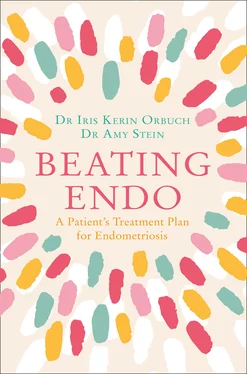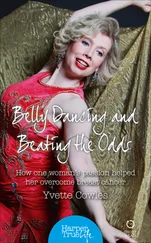When I called my ob-gyn to tell her that I was once again hospitalized for another erupted ovarian cyst, she said, “Susan, have you had enough? Are you done?”
I love you, Maria, for saying that.
Yes. Yes. Yes. I was done, but why was this happening? My ob-gyn had operated on me six years before when another ovarian cyst erupted. She cleaned up my ovary and removed more potential cyst tissue. I thought that was the end of my pain, but it wasn’t.
The last ER visit was my final straw. I sat in my ob-gyn’s office and had a complete meltdown. “What do we do? What’s wrong with me? Why does this keep happening?” I begged for clarity, tears streaming down my face.
My ob-gyn did her best to answer my questions but recommended I talk with an endometriosis specialist. She referred me to Dr. Iris Orbuch. “Dr. Iris is the best person to see about endo,” my doctor said. “This is her practice’s entire focus.”
Little did I know that this conversation would ultimately save my life.
Two weeks later I was sitting in Dr. Orbuch’s Los Angeles office. For the first time in decades, I felt like I was going to be okay.
The first thing I learned from Dr. Orbuch was that endometriosis is incredibly difficult to diagnose. Many women begin to develop symptoms in their teenage years and spend their lifetimes in enormous pain, even risking infertility.
Traditional ob-gyns are trained to deliver babies and give Pap smears, so the mysterious workings of the beast that is endometriosis often fall through the cracks. Simply put, lots of doctors just don’t know about it because it’s so difficult to see.
But Dr. Iris Orbuch promised me that I would get my life back. And she was 100 percent right.
My surgery lasted close to four hours. Mine was a very severe case; endo had spread all over my ovaries, ureters, colon, and fallopian tubes.
Less than six months later, I was absolutely TRANSFORMED. My husband and child hardly recognize me now. I skip around the house, cook a mean lasagna, and have absolutely zero pain. I’m outside kicking soccer balls with my boy, at every one of his basketball games, and I’m the first one to stand up and do the wave at Dodger Stadium. I am free. I am brand-new. I don’t hurt anymore. I’ve donated my dozen heating pads and hot water bottles to the neighborhood yard-sale bin. Finally, I can live my life to the fullest.
Here are some life-altering facts that I learned from Dr. Iris:
Women are told we should be tough and that periods are painful so we should just grin and bear it.
Women are made to feel crazy and are deemed “too difficult” for complaining about period pain.
A period is NOT supposed to knock you out of your life.
1 out of 10 women suffer from endometriosis. That’s approximately 176 million women worldwide.
In the end, I was lucky. I’ve lived the California lifestyle for over thirty years, eating healthy—kale smoothies for breakfast—plus doing an hour of cardio a day, followed by meditation. I’m very aware of the mind-body connection and always sought out a holistic view of health and aging. It’s why I was completely floored when I found out I had an advanced case of endometriosis. How, after all those gluten-free muffins and uphill sprints, could I still get this outrageously painful disease? What’s the point of attending to my health if I’m just going to end up on a cold operating table?
The answer is that all that good nutrition, regular exercise, and daily meditation—all that healthy living—got me up off the operating table faster. My body was primed when I went into surgery—primed to take the hit and bounce back. Four evenings after my radical hysterectomy, I was sitting at my favorite restaurant in Malibu eating California rolls. I was truly astonished at how much better I felt. No more pain. My lifestyle made it possible.
I would tell someone suffering from endometriosis to make changes NOW to support your mental and physical health. Go to physical therapy, visualize how you want to feel before and after surgery, meditate, eat colorful, life-affirming foods. Cast a large net to boost and support optimum health before and after surgery. Life is just too short to suffer from this crippling disease.
Introduction: Beating Endometriosis
Remember the first time you heard the word endometriosis ?
As with any new word—especially one so multisyllabic—you probably tucked it into your brain and forgot about it, until suddenly it seemed you were hearing it everywhere. Maybe a friend said it ran in her family. Or another friend said her physical therapist thought it might be the cause of her pelvic pain. Or someone said her urologist told her to ask her gynecologist about it. Somebody somewhere even said that her nutritionist mentioned it.
Then a few celebrities announced they had it, so for a couple of days, it was in the news and in the blogosphere—the latest social media meme. The sudden attention unleashed a volley of pronouncements: Endometriosis is all about bad cramps . . . Birth control pills cure it . . . Surgery cures it . . . Only a hysterectomy can cure it.
All untrue, by the way.
Yet despite all the mentions and myths, we’ll bet you nevertheless will be shocked to learn that endo, as it is routinely called, is estimated to affect one-tenth of all the girls and women on earth.
Think about that. The next time you’re walking along a crowded sidewalk, or are on a bus, or are part of the audience at a movie or concert or some other event, look around you. Pick out the first ten females you see and tell yourself that one of them is likely to suffer from endometriosis. Her suffering might range from mild discomfort to intense pain, from an occasional nuisance to chronic agony, from something she can put up with to something that stunts her life.
What is this disease whose symptoms attract the attention of urologists as well as gynecologists, acupuncturists, pain psychologists, and specialist surgeons, a disease that wears so many different hats and shows up in so many different forms? Since it is known traditionally, if at all, as a “female disease”—and therefore is not much discussed except in whispers—why is a nutritionist talking about it? What do muscle pain and physical therapy have to do with it? And if it does “run in the family” and is therefore genetically transmitted, doesn’t that mean that one in ten of us are just destined to get endometriosis and can’t do much about it once we do?
No. We can answer with certainty that while endometriosis can indeed be genetically transmitted, many other factors may influence its development, and whatever the cause, there is a great deal you can do about the disease. That is what we will tell you about in this book, in which we will arm you with the most powerful weapon you can wield to beat this disease and live the life you deserve—namely, the knowledge you’ll gain in the pages that follow. Understanding the disease—knowing what you’re up against—is crucial to beating the disease. It’s the starting point.
We are a gynecologist and a physical therapist linked by a shared and passionate commitment to caring for the women and girls who suffer from endometriosis. We came to this shared commitment from different healthcare specialties, as you can see from the initials attached to our names, and we arrived at it from different beginnings and along different paths. Pretty much from the start of our careers as medical doctor and doctor of physical therapy, each of us found ourselves caring for female patients whose symptoms ranged from pelvic pain to abdominal bloating to painful periods to diarrhea or constipation to fatigue and depression to infertility. Not particularly unusual in either practice, yet in too many instances, the ailments did not seem to yield to the standard treatments our specialties prescribed. And while each of us focused intently on doing whatever we could with the expertise we possessed, we sensed there had to be more we should be doing if we were to achieve a comprehensive cure. Patients got better. Substantially better. Often vastly better. But not 100 percent better.
Читать дальше











